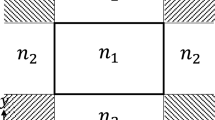Abstract
A complex envelope approach for the numerical solution of Maxwell’s equations based on Faber polynomial expansions is investigated. The Faber polynomial expansion used for the approximation of the exponential time propagator offers a highly accurate and efficient calculation while allowing the application of large time steps. The complex envelope approach incorporates only the envelope around a carrier frequency. This is especially beneficial when bandlimited source field distributions are investigated as it is the case for many applications from terahertz technology or photonics.







Similar content being viewed by others
References
Al-Mohy, A.H., Higham, N.J.: Computing the action of the matrix exponential, with an application to exponential integrators. SIAM J. Sci. Comput. 33(2), 488–511 (2011)
Borisov, A.G., Shabanov, S.V.: Wave packet propagation by the Faber polynomial approximation in electrodynamics of passive media. J. Comput. Phys. 216(1), 391–402 (2006)
Busch, K., Niegemann, J., Pototschnig, M., Tkeshelashvili, L.: A Krylov-subspace based solver for the linear and nonlinear Maxwell equations. Physica Status Solidi (b) 244(10), 3479–3496 (2007)
De Raedt, H., Michielsen, K., Kole, J., Figge, M.: Solving the Maxwell equations by the Chebyshev method: a one-step finite-difference time-domain algorithm. IEEE Trans. Antennas Propag. 51(11), 3155–3160 (2003)
Ellacott S.: A survey of Faber methods in numerical approximation. Comput. Math. Appl. 12(5-6), 1103–1107 (1986)
Fahs, H.: Investigation on polynomial integrators for time-domain electromagnetics using a high-order discontinuous Galerkin method. Appl. Math. Model. 36(11), 5466–5481 (2012)
Gedney, S.D., Zhao, B.: An auxiliary differential equation formulation for the complex-frequency shifted PML. IEEE Trans. Antennas Propag. 58(3), 838–847 (2010)
Helfert, S., Pregla, R.: A finite difference beam propagation algorithm based on generalized transmission line equations. Opt. Quantum Electron. 32(6–8), 681–690 (2000)
Hochbruck, M., Ostermann, A.: Exponential integrators. Acta Numer. 19(May), 209–286 (2010)
Huisinga, W., Pesce, L., Kosloff, R., Saalfrank, P.: Faber and Newton polynomial integrators for open-system density matrix propagation. J. Chem. Phys. 110(12), 5538–5547 (1999)
Kleene H., Schulz D.:Concept of a complex envelope faber polynomial approach for the solution of Maxwell’s equations. In: 2018 IEEE MTT-S Int. Conf. Numer. Electromagn. Multiphysics Model. Optim., IEEE, 6, pp 1–3 (2018a)
Kleene, H., Schulz, D.: On the evaluation of sources in highly accurate time domain simulations on the basis of faber polynomials. In: Progress in Electromagnetics Research Symposium (PIERS), p 2A03 (2018b)
Kleene, H., Schulz, D.: Time domain solution of Maxwell’s equations using Faber polynomials. IEEE Trans. Antennas Propag. 66(11), 6202–6208 (2018c)
Ma, F.: Slowly varying envelope simulation of optical waves in time domain with transparent and absorbing boundary conditions. J. Light Technol. 15(10), 1974–1985 (1997)
Ma, C., Chen, Z.: Stability and numerical dispersion analysis of CE-FDTD method. IEEE Trans. Antennas Propag. 53(1), 332–338 (2005)
Namiki, T.: A new FDTD algorithm based on alternating-direction implicit method. IEEE Trans. Microw. Theory Technol. 47(10), 2003–2007 (1999)
Novati, P.: Solving linear initial value problems by Faber polynomials. Numer. Linear Algebra Appl. 10(3), 247–270 (2003)
Pursel, J., Goggans, P.: A finite-difference time-domain method for solving electromagnetic problems with bandpass-limited sources. IEEE Trans. Antennas Propag. 47(1), 9–15 (1999)
Taflove, A., Hagness, S.C.: Computational Electrodynamics: The Finite-Difference Time-Domain Method, 3rd edn. Artech House, Norwood (2005)
Taflove, A., Oskooi, A., Johnson, S.G.: Advances in FDTD Computational Electrodynamics: Photonics and Nanotechnology, 1st edn. Artech House, Norwood (2013)
Yee, K.: Numerical solution of initial boundary value problems involving Maxwell’s equations in isotropic media. IEEE Trans. Antennas Propag. 14(3), 302–307 (1966)
Acknowledgements
This work was supported by the German research funding association Deutsche Forschungsgemeinschaft under Grant SCHU 1016/6-1.
Author information
Authors and Affiliations
Corresponding author
Additional information
Publisher's Note
Springer Nature remains neutral with regard to jurisdictional claims in published maps and institutional affiliations.
Rights and permissions
About this article
Cite this article
Kleene, H., Schulz, D. Complex envelope Faber polynomial method for the solution of Maxwell’s equations. Opt Quant Electron 51, 381 (2019). https://doi.org/10.1007/s11082-019-2099-y
Received:
Accepted:
Published:
DOI: https://doi.org/10.1007/s11082-019-2099-y




